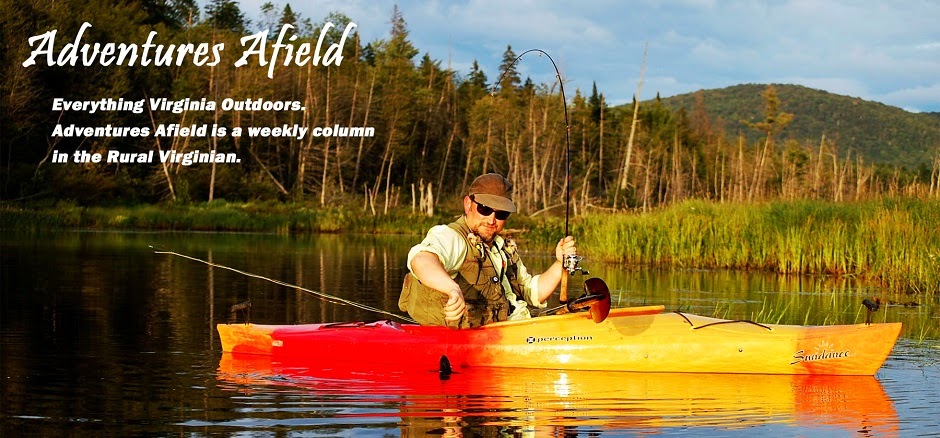Thinking about plans for summer outdoor fun? Nothing
says “summer” quite like a day spent on the river boating, fishing, or both.
Luckily, moving water is a resource that Central Virginia has in ample supply.
The James River, Virginia’s founding river, and the Rivanna River provide
nearly 100 miles of floatable water in the heart of the Old Dominion, along
with world-class smallmouth and catfishing that only gets better as the summer
progresses. Several outfitters are set up on each of these rivers, too, working
to provide you with an experience catered to your interests.
The James River flows almost 55 miles through Central
Virginia towards its mouth in the Chesapeake Bay. Along the way, its many
riffles and long flats are lined with beautiful scenery and wildlife, and hold
trophy-sized smallmouth and catfish (and other species) to keep the angler
busy.
Ashley Denby realized the boating potential of the
James River in establishing James River Reeling and Rafting, an outfitting
company based in Scottsville, on the banks of the River.
 |
| Two happy James River Reeling and Rafting customers. |
Seven days a week, from April to October, Denby rents everything from tubes to rafts, and offers self-guided trips to accommodate every skill level, from beginners tubing a few lazy miles downriver, to trail-blazing river rats camping out on the river overnight. Rental prices include everything you’ll need on the river—a shuttle to and from your destination, a boat, life jackets, and paddles, and a map and cooler if requested.
Despite the name, James River Reeling and Rafting
doesn’t provide fishing equipment or instruction. If fishing is your activity of
choice, you’re better off hiring a local guide seasoned on the James River and
the personality of its famous smallmouth and catfish.
L.E. Rhodes is a guide of nearly 20 years who
specializes in fly fishing for smallmouth bass, and is intimately familiar with
the James River.
“The James River offers some of the best quality
smallmouth fishing in Central Virginia,” said Rhodes. “You may not catch the
number of fish in a day as you would years ago, but the average size of 14 to
17 inches, along with the fish up to and over 20 inches that you’ll encounter,
makes for an awesome day on the river.”
Rhodes, who can teach fishermen of all skill levels
how to be a better smallmouth fisherman, is as easy-going and enthusiastic of a
guy as you’ll encounter on the James River or anywhere else. And why shouldn’t
he be, spending his days teaching others in one of his favorite places?
“I love to share my experience and love of the James
and it's smallmouth with all,” said Rhodes.
Brian Bodine, owner of Razorback Guide Service, based
in Scottsville, is another such character. Bodine has offered hunting and
fishing trips on the James River year-round for more than 20 years, and has
spent the last 30 years learning the intricacies of the River.
 |
| Brian "Razorback" Bodine with a citation James River smallmouth. Photo by Matt Reilly. |
Though Bodine also offers light tackle smallmouth
trips, he also specializes in catfishing.
“Catfishing has grown in popularity over the last few
years,” said Bodine. “Though the upper James doesn’t get the 100-pound blue
cats like the Richmond area, we do well. We catch flatheads up to 50 pounds and
blues into the upper 30's. Plenty of meat fish in the 5-8 lb range as well.”
Want to experience the best fishing the James has to
offer? Bodine offers a specialized trip starting in late afternoon fishing for
smallmouth, and then switching over to catfish as the sun goes down.
Dear to residents of Fluvanna County, Charlottesville,
and beyond, the Rivanna River is a prominent tributary to the James, and also
offers excellent boating and fishing.
Gabe and Sonya Silver work to convince Rivanna
visitors of the River’s boating potential through their family outfitting
business, the Rivanna River Company. Based in Charlottesville, the Silvers rent
tubes and boats, and offer both self-guided trips and guided tours and
instruction on the River.
Fishing on the Rivanna is similar to the James River,
in that it has many of the same target species, though in a more intimate
setting.
“The Rivanna boasts a wonderful smallmouth population,
and can produce trophies,” said Spotswood Payne, fly fishing guide for TheAlbemarle Angler. “There are also good populations of big gar and carp, too,
and even the occasional goldfish. The Rivanna also provides a bit more gradient
than the James, and can be quite fun to paddle at higher flows.”
Payne, who also guides on the James River, notes that
the Rivanna is also steeped in a rich history, something that is strongly
evident while floating it, and played a significant role in the settlement of
Charlottesville and Monticello.
Consider these backyard destinations for fun and
relaxation this summer, and you may just discover something spectacular.
*Originally published in The Rural Virginian


